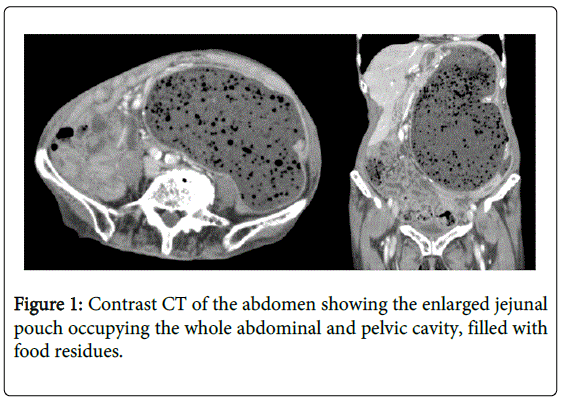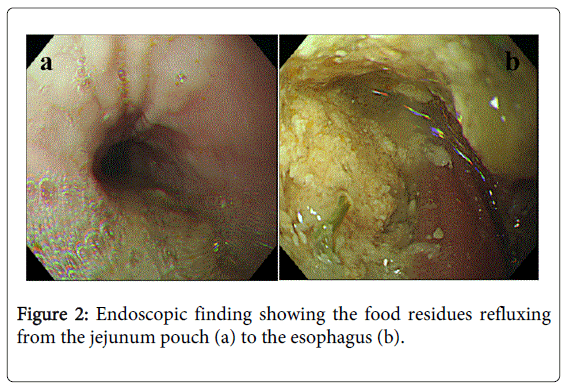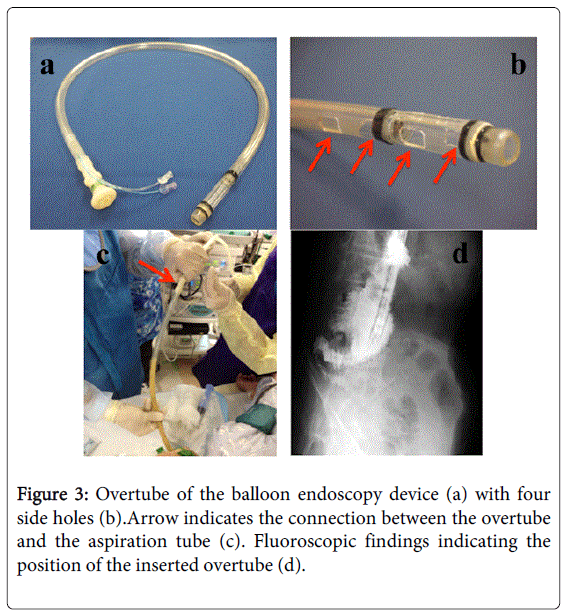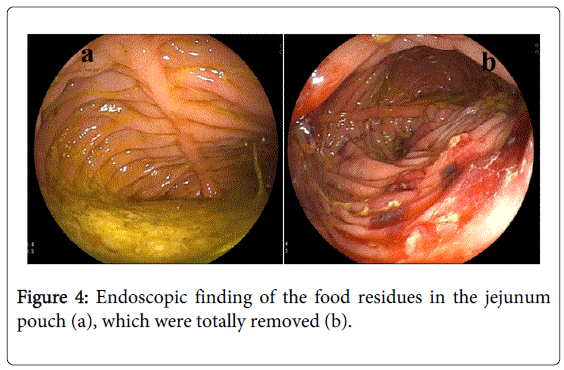Case Report Open Access
An Improvement of an Ileus in the Jejunal Pouch by Aspiration with the Overtube of a Balloon Endoscopy: A Case Report
Takahiro Amano1,5, Toshio Kuwai1*, Akiyoshi Tsuboi1, Kazuki Boda1, Ken Yamashita1, Yuichi Hiyama1, Takeshi Mizumoto1, Toshiki Yamaguchi1, Atsushi Yamaguchi1, Hirotaka Kouno1, Kiyomi Taniyama2,3,4, and Hiroshi Kohno1
1Department of Gastroenterology, National Hospital Organization Kure Medical Center and Chugoku Cancer Center, Hiroshima, Japan
2Department of Diagnostic Pathology, National Hospital Organization Kure Medical Center and Chugoku Cancer Center, Hiroshima, Japan
3Department of Institute for Clinical Research, National Hospital Organization Kure Medical Center and Chugoku Cancer Center, Hiroshima, Japan
4President, National Hospital Organization Kure Medical Center and Chugoku Cancer Center, Hiroshima, Japan
5Department of Gastroenterology, Toyonaka Municipal Hospital, Toyonaka, Japan
- *Corresponding Author:
- Toshio Kuwai, M.D.
Department of Gastroenterology
National Hospital Organization Kure Medical
Center and Chugoku Cancer Center
3-1 Aoyama, Kure, Hiroshima
737-0023, Japan
Tel: +81-823-22-3111
Fax: +81-823-21-0478
E-mail: kuwait@kure-nh.go.jp
Received date: May 18, 2015; Accepted date: June 22, 2015; Published date: June 26, 2015
Citation: Amano T, Kuwai T, Tsuboi A, Boda K, Yamashita K, et al. (2015) An Improvement of an Ileus in Thejejunal Pouch by Aspiration with the Overtube of a Balloon Endoscopy: A Case Report. J Gastrointest Dig Syst 5:301. doi:10.4172/2161-069X.1000301
Copyright: © 2015 Amano, et al. This is an open-access article distributed under the terms of the Creative Commons Attribution License; which permits unrestricted use; distribution; and reproduction in any medium; provided the original author and source are credited.
Visit for more related articles at Journal of Gastrointestinal & Digestive System
Abstract
We report a case of an 86-year-old Japanese woman diagnosed with a food-induced ileus whose condition improved by aspiration with the overtube of a balloon endoscopy. She had undergone a total gastrectomy for gastric cancer and reconstruction by Roux-en Y anastomosis and jejunum pouch 17 years earlier. She complained of constipation and loss of appetite lasting more than 1 wk before admission. Her left abdomen showed gradual fullness, and tenderness was also found at the same site. Contrast computed tomography (CT) of the abdomen showed that the jejunal pouch lumenwas markedly expanded by food residue and was pressed into the intestinal tract of the small intestine. Gastrointestinal endoscopy revealed that the food residue was fluid and flowed back up into the esophagus, and the jejunum pouch was filled with food residue. As the patient was elderly, we attempted to aspirate the food residue with the overtube of a balloon endoscopy device. Food-induced ileus has been improved by surgery in the past; however, in determining treatment for ileus it is always necessary to consider the individual patients’ conditions, including the gastrointestinal contents.
Keywords
Jejunal pouch ileus; Balloon endoscopy; Overtube; Aspiration; Gastrectomy
Introduction
Food-induced ileus is a rare disease that accounts for < 1% of all cases of ileus. Food-induced ileus is often caused by eating too much food that has a high level of fiber or is difficult to digest, by eating too quickly food that absorbs moisture and swells easily, by a masticatory disturbance such as that caused by an artificial tooth, or by an organic change such as adhesion after laparotomy or gastrectomy [1,2,3]. The characteristic finding of food residue by computed tomography (CT) is a low-density, sponge-like area due to its air content [4]. Almost all cases of food-induced ileus are improved by surgery. However, our patient’s very rare case of food-induced ileus not accompanied by hypochylia was treated conservatively by aspiration of the liquid food residue using the overtube of a balloon endoscopy.
Case Report
An 86-yr-old Japanese woman was admitted to our hospital’s neurology department for treatment of a peripheral neurological condition. She also complained of constipation and loss of appetite that had lasted for more than 1 wk before admission. She had undergone a total gastrectomy for gastric cancer and reconstruction by Roux-en Y anastomosis and jejunum pouch 17 yrs earlier. Her temperature was 38.1°C, but her other vital signs were normal. Her left abdomen showed gradual fullness, and tenderness was also found at the same site. The laboratory data showed a white blood cell count of 12,000/μL (neutrophilic leukocytes were 86.9%) and C-reactive protein was 4.9 mg/dL. Other complete blood cell and biochemistry data were normal. Contrast CT of the abdomen showed that the enlarged jejunal pouch lumen followed the pelvic cavity, which was markedly expanded by food residues and pressed the tract of the small intestine (Figure 1). Gastrointestinal endoscopy revealed that the food residues refluxed into the esophagus and that the jejunum pouch was filled with the liquid food residues (Figure 2). We therefore diagnosed food-induced ileus.
It was not possible to improve the patient’s condition through a stomach tube or endoscopy. As thepatient was elderly and required non-invasive treatment, we attempted to aspirate the food residues with the overtube of a balloon endoscopy device. We opened the side holes at the distal end of the overtube (Figure 3) and inserted it into the jejunum pouch. After withdrawing the endoscope, we connected the overtube to the aspiration tube and aspirated the food residue under fluoroscopic guidance (Figure 3) and under sedation with midazolam. We aspirated about 800ml food residue for 30 minutes once. This was repeated so that almost all of the residue was aspirated (Figure 4). Following this procedure, the patient’s symptoms improved rapidly was not relapsed with drug adjustment and proper nutrition. Furthermore, the jejunal pouch returned to its initial form. Then, we investigated and went the medication by intravenous immunoglobulin for a peripheral neurological condition.She was discharged 39 days after being admitted.
Discussion
Between 1986 and 2013, 80 cases of food-induced ileus after gastrectomy were reported in Japan. These patients had a mean age of 63.7 yrs, and the mean time between gastrectomy and the diagnosis of ileus was 20.8 yrs. Thus, reports of food-induced ileus developing long after the gastrectomy, as in this case, are not at all unusual [5,6,7].
Since most such patients present with hypochylia caused by gastrectomy and pyloric incompetence caused by the loss of pylorus, in almost all cases the pylorus has been ablated [5,6,8]. In addition, it is understood that the insertion of a jejunum pouch and loss of the vagus nerve prolong food retention [9]. The present case was thus diagnosed as food-induced ileus.
As the obstruction of the intestinal tract worsens rapidly in cases of food-induced ileus, the circulatory failure and enhancement of vascular permeability caused by the retention of the intestinal contents, edema and expansion progress rapidly. Patients often have peritoneal irritation, and food-induced ileus may develop into a strangulation ileus. It was reported that 83% of cases of food-induced ileus had peritoneal irritation [10]. Thus, most cases of food-induced ileus are improved by surgery. However, in determining treatment for ileus, it is always necessary to consider the individual patient’s conditions, including the intestinal contents.
For some food-induced ileus patients, it is possible to achieve improvement or cure with conservative treatment using existing equipment instead of resorting to highly invasive treatment. It is important to consider the background and status of each patient before determining their treatment.
References
- Park SE, Ahn JY, Jung HY, Na S, Park SJ, et al. (2014) Clinical outcomes associated with treatment modalities for gastrointestinal bezoars. Gut Liver 8: 400-407.
- Erzurumlu K, Malazgirt Z, Bektas A, Dervisoglu A, Polat C, et al. (2005) Gastrointestinal bezoars: a retrospective analysis of 34 cases. World J Gastroenterol 11: 1813-1817.
- Minami A (1973) Gastric bezoars after gastrectomy. Am J Surg 126: 421-424.
- Altintoprak F, Degirmenci B, Dikicier E, Cakmak G, Kivilcim T, et al. (2013) CT findings of patients with small bowel obstruction due to bezoar: a descriptive study. ScientificWorldJournal 2013: 298392.
- Yang JE, Ahn JY, Kim GA, Kim GH, Yoon da L, et al. (2013) A large-sized phytobezoar located on the rare site of the gastrointestinal tract. Clin Endosc 46: 399-402.
- Chisholm EM, Leong HT, Chung SC, Li AK (1992) Phytobezoar: an uncommon cause of small bowel obstruction. Ann R Coll Surg Engl 74: 342-344.
- Ichiba H, Honda H, Hayashi T, Koyama I, Sato S (1996) Intestinal obstruction due to persimmon bezoars 25 years following a selective vagotomy with pyloroplasty. The Journal of the Japanese Practical Surgeon Society 57: 2482-2485.
- Amjad H, Kumar GK, McCaughey R (1975) Postgastrectomy bezoars. Am J Gastroenterol 64: 327-331.
- Andrus CH, Ponsky JL (1988) Bezoars: classification, pathophysiology, and treatment. Am J Gastroenterol 83: 476-478.
- Yamasaki Y, Yamaoka H, Nishikawa H, Tanaka M, Nakajima K (2004) Two cases of dietetic ileus caused by rice cakes. The Journal of the Japan Surgical Association 65: 2362-2367.
Relevant Topics
- Constipation
- Digestive Enzymes
- Endoscopy
- Epigastric Pain
- Gall Bladder
- Gastric Cancer
- Gastrointestinal Bleeding
- Gastrointestinal Hormones
- Gastrointestinal Infections
- Gastrointestinal Inflammation
- Gastrointestinal Pathology
- Gastrointestinal Pharmacology
- Gastrointestinal Radiology
- Gastrointestinal Surgery
- Gastrointestinal Tuberculosis
- GIST Sarcoma
- Intestinal Blockage
- Pancreas
- Salivary Glands
- Stomach Bloating
- Stomach Cramps
- Stomach Disorders
- Stomach Ulcer
Recommended Journals
Article Tools
Article Usage
- Total views: 14429
- [From(publication date):
June-2015 - Feb 01, 2025] - Breakdown by view type
- HTML page views : 10070
- PDF downloads : 4359




